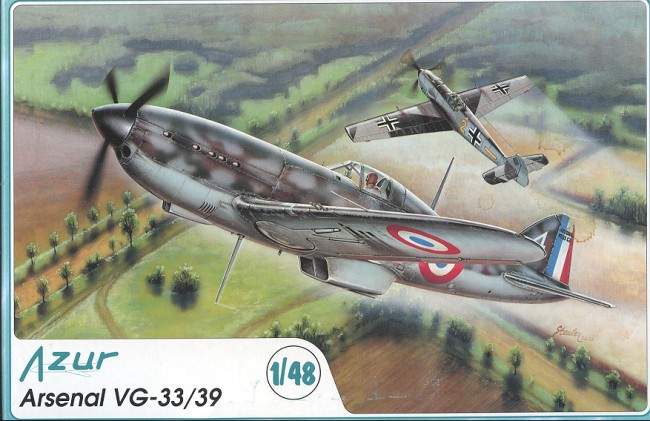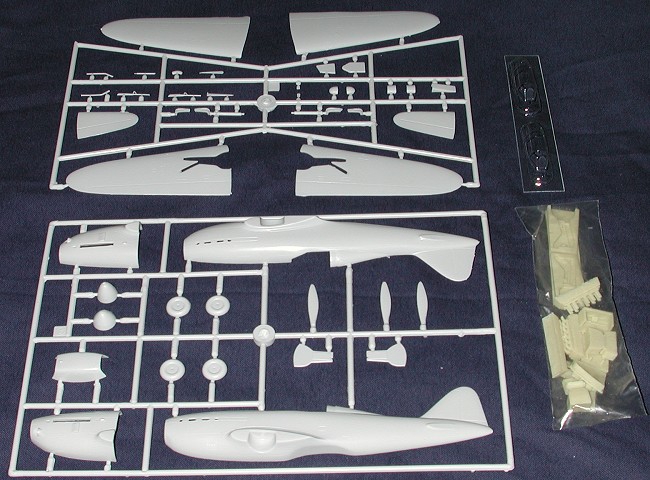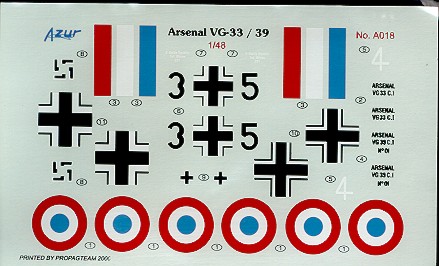
|
KIT: |
Azur 1/48 Arsenal VG-33/39 |
|
KIT # |
018 |
|
PRICE: |
$ |
|
DECALS: |
See review |
|
REVIEW & |
|
|
NOTES: |
Multimedia short run kit |

|
HISTORY |
In 1937, a competition was held to determine a replacement for the MS.406 then in service. Four aircraft participated in that competition; the D.520, CAO 200, MS.450 and the VG.33. Developed from the VG.30 lightweight fighter that was pitted against the Caudron C.713, the VG.33 was very similar to the earlier VG.31 and 32, though powered by a different engine. In this case it was the Hispano-Suiza12Y-31 of 860 hp. The aircraft was armed with 4 7.5mm machine guns and a single 20mm cannon.
The prototype first flew in August 1939 and attained a maximum speed of 347 mph, a respectable speed for the time. Various uprated motors were tested in subsequent prototypes and the third prototype was used as a production prototype; an order for 200 examples having been made a few weeks after the Munich Crisis. Such was the state of European concern over the intentions of the Germans that often aircraft were ordered into production before the prototype had flown, as was the case here.
By the time of the French surrender in June of 1940, 160 examples were in various stages of assembly at the factory. Of these, a dozen were hidden until discovered by the Germans in late 1942. It is not known if any of these aircraft reached operational units or if they participated in any combat. Apparently some of these aircraft were used by the Germans as fighter trainers.
An improved version of the VG.33, the VG.39 had a 1,280 hp Hispano engine and an armament of six 7.5 mm machine guns, reached a speed of 389mph in tests. These tests were stopped by the approach of German forces and no further work was done on the aircraft.
|
THE KIT |

As with most short run kits from the MPM family, Azur kits are very buildable and offer some very interesting subjects, all of which served in the French Air Force at one time or another. This is highly commendable as there are darn few aircraft of French origin from this time kitted, aside from those produced by Heller 25-30 years ago.
If you have built a Czech short run kit in the last 5-10 years, this model will look very familiar. It has the usual trapping of a limited production model: no alignment pins, large ejector pin stubs on the big parts like wings and fuselage, relatively thick sprue gates (though these are getting smaller all the time), vacuformed canopies and resin or etched metal bits.
This particular kit is quite well done with superb panel line detail and minimal flash. There are also no ejector pin marks on any of the smaller pieces, which is quite nice indeed. There are two (thank you) very clear vacuformed canopies for those of us who mess up the first one. The resin pieces are superbly done and in this case consist of wheel wells, interior (all of it), oleo scissors and the two sets of exhaust. Unfortunately, packing the delicate in with the hefty has cause some breakage of parts, which is a shame and can be difficult to repair. Not sure what to suggest other than packing all the delicate bits separately from the larger castings.
The method of offering two different aircraft is rather unique in this kit. As I mentioned in the history, most of the Arsenal VG 30 series aircraft use the same airframe, changing basically only the engine to do the different subtypes. Actually there is a bit more to it than that, but this is the basic premise. Azur accomplishes this by offering a separate nose if you want to do the later VG.39. All you do is cut away the old one and graft on the new one. Different resin exhaust are offered as is a different spinner. What is not offered is the 6 gun wing so you will have to do a bit of research and modification to the wing for that. You will also notice the separate prop blades which are to be glued directly to spots on the spinner. You know how I feed about separate blades and can only hope that folks like those at Azur will start molding them as one unit.
 Instructions are
typical offering 9 construction steps within the 8 pages. Construction sequences
are logical and colors needed in various steps are shown. The color chart is not
keyed to any specific paint and colors are generic with no FS 595 reference, not
that it would apply to French colors anyway. You get decals for three aircraft;
two VG.33s and one VG.39. All are in a freehand camouflage of mid-blue-grey,
khaki, and brown over light blue grey. These colors were in the Aeromaster range
and you should also be able to get them in Xtracolor and perhaps Polly Scale or
Testors. The VG.39 is the prototype and the VG.33 is offered as a German trainer
or test aircraft and in French Markings with the number 4 on the tail. Decals
are by Propagteam and are everything you would expect from them: in register,
good colors and thin. The rudder stripes are given as three different strips to
be added to the rudder and then trimmed to fit.
Instructions are
typical offering 9 construction steps within the 8 pages. Construction sequences
are logical and colors needed in various steps are shown. The color chart is not
keyed to any specific paint and colors are generic with no FS 595 reference, not
that it would apply to French colors anyway. You get decals for three aircraft;
two VG.33s and one VG.39. All are in a freehand camouflage of mid-blue-grey,
khaki, and brown over light blue grey. These colors were in the Aeromaster range
and you should also be able to get them in Xtracolor and perhaps Polly Scale or
Testors. The VG.39 is the prototype and the VG.33 is offered as a German trainer
or test aircraft and in French Markings with the number 4 on the tail. Decals
are by Propagteam and are everything you would expect from them: in register,
good colors and thin. The rudder stripes are given as three different strips to
be added to the rudder and then trimmed to fit.
Overall, it looks like a very nice model. It should not be any problem for the more experienced builder and its relatively straight-forward design and simplicity would make for a good introduction to the world of 1/48 short run kits.
|
REFERENCES |
Warplanes of the Second World War: Fighters, Volume 1 by William Green, Doubleday, 1960
If you would like your product reviewed fairly and quickly by a site that has over 1,500 visits a day, please contact me or see other details in the Note to Contributors.